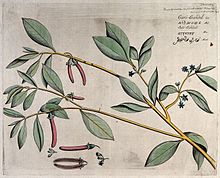Bruguiera cylindrica
| Bruguiera cylindrica | |
|---|---|
 |
|
| Scientific classification | |
| Kingdom: | Plantae |
| Clade: | Angiosperms |
| Clade: | Eudicots |
| Clade: | Rosids |
| Order: | Malpighiales |
| Family: | Rhizophoraceae |
| Genus: | Bruguiera |
| Species: | B. cylindrica |
| Binomial name | |
|
Bruguiera cylindrica (Linnaeus) Blume |
|
| Synonyms | |
|
|
Bruguiera cylindrica is a mangrove in the family Rhizophoraceae. In the Malay language it is known as bakau putih. It grows in mangrove swamps in south east Asia.
Bruguiera cylindrica is a small tree growing up to 20 metres (66 ft) tall but often grows as a bush. The bark is smooth and grey, with corky raised patches containing lenticels which are used in gas exchange and the trunk is buttressed by roots. The aerial roots or pneumatophores project from the soil in knee-shaped loops and have many lenticels which allow air into the interconnecting roots while excluding water. The roots spread out widely to provide stability in the waterlogged soil. The glossy green leaves are opposite, simple and elliptical with pointed ends. The flowers are in small bunches of 2-5 in the axils of the leaves. They have 8 long green sepals and 8 smaller, greenish-white petals with several little bristles on the tip. The flowers are pollinated by insects and release a cloud of pollen when probed at the base by the insect's mouthparts. The seed does not detach itself from the flower stalk but germinates where it is and is known as a propagule. It grows into a slightly curved cylinder up to 15 cm (6 in) long, with the upturned calyx still attached, and looks rather like a slender, dangling cucumber. The propagules later drop off and float horizontally at first. The roots (lower part) absorb water and become heavier and after a few weeks the propagules float vertically and are ready to root into the substrate.
Bruguiera cylindrica can be confused with Bruguiera gymnorhiza, but that has larger, red flowers and red sepals which remain attached to the propagule, which is a straight cylinder in shape rather than being slightly curved.
Bruguiera cylindrica is found in south east Asia with the range extending from India and Sri Lanka through Malaysia, the Philippines, Indonesia and Papua New Guinea to Queensland, Australia. It is one of the commonest mangroves in Singapore.Bruguiera cylindrica is found on new deposits of silt, often behind other mangroves such as Avicennia which are more salt tolerant. Unlike some other mangroves, it does not regenerate easily from broken off branches.
...
Wikipedia
